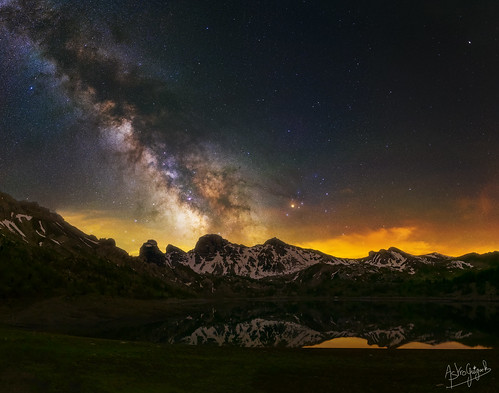Lights from ... the Zodiacal light and Airglow after sunset
In the heart of the Chilean Andes, the view blows out your mind. In the neighborhood of Cerro Tololo, this panorama was taken towards West horizon and the pacific Ocean. At 80 km, the city of La Serena can be found, as you can easily imagine in this picture. Unfortunately, the city is highlighted by a yellow halo because of artificial light.
Despite this light pollution, the sky remains surprisingly clear and spotting the zodiacal light becomes an easy task. Zodiacal light appears as a cone of diffuse white light. It can be explained by the scattering of sunlight by inter-planetary dusts in space. These particles are mainly gathered in the orbital plane of our solar system, called ecliptic Therefore zodiacal follows this imaginary line in the sky.
A strong activity of airglow happened during that night. The entire orange tint you can see here is indeed produced by airglow itself! This phenomenon has a similar aspect as aurorae but has a different origin. During the day, molecules and atoms of our atmosphere are hit by Ultra-violet radiations from our Sun. This intense incident flux starts a slow chemical reaction process which releases a light glow when night falls. It is called chemiluminescence and produces some amazing colors in respect to the chemical elements involved in the reaction. For example, Sodium is responsible of yellow airglow, molecular oxygen gives green airglow whereas atomic oxygen tints airglow with red-orange color.
In Chile, airglow is a really common phenomenon, especially in winter. Sometimes, it is even disturbing astronomers since its light is too bright. Then it becomes a natural source of light pollution.
Its origin still remains a mystery. Scientists suggest that the activity of airglow should be related first to solar cycles and second to global warming.
Technical Details....
📷 Canon Rebel T5i + Sigma Art 18-35mm f/1.8 lens
→ 5 stitched pictures taken in portrait mode
→ Single 15 seconds exposure
→ ISO 3200
→ 18 mm
→ f/1.8
Softwares: Dxo Optics pro 9 for noise reduction / Lightroom for all the edits / Microsoft ICE for the final stitching.
→ 5 stitched pictures taken in portrait mode
→ Single 15 seconds exposure
→ ISO 3200
→ 18 mm
→ f/1.8
Softwares: Dxo Optics pro 9 for noise reduction / Lightroom for all the edits / Microsoft ICE for the final stitching.







No comments:
Post a Comment
Feel free to drop me a comment!